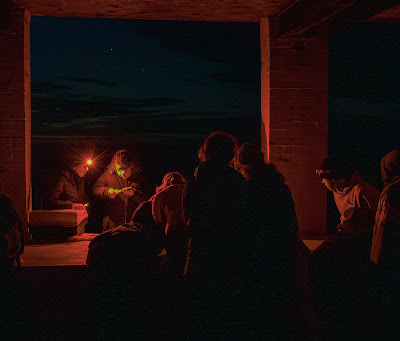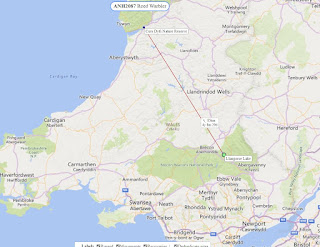Regular ringing at Cors Caron (Ceredigion) is continuing to produce a variety of species, some not regular at our other sites. This juvenile Redstart and adult male Whinchat - fine examples.
 |
| Juvenile Redstart |
 |
| Adult male Whinchat |
Arfon is hoping that this year's CES style effort will result in Cors Caron becoming another CES for the TRG.
On the north Pembs coast our Linnet RAS site is continuing to catch well.
This leucistic Linnet stood out from the regular plumage birds. The last two sessions have produced mostly juvenile birds, presumably the adults now on second nesting attempts.
A colour ringed Osprey was around the Teifi from the 30th May until the 6th June.
 |
| Osprey 7H6 - Stuart Hall |
Many thanks to several photographers for reporting this bird from Curlew Hide on the Teifi Marshes. It was one of a brood of three ringed 10km south of Inverness, on a platform that the nest was moved to after a couple of years of having the original nest site robbed in the mid 90’s.
The birds have since been successful in all except one year and usually manage to fledge three chicks as they did in 2022 when Jon Brain ringed this one on 1 July. The nest has had a spectacular success rate for subsequent sightings including a bird seen in Guinea Bissau. Thanks to Jon Brain for the news and photos.
 |
| Osprey 7H6 at the time of ringing - Jon Brain |
Pied Flycatcher studies...
 |
| Pullus Pied Flycatcher - Naomi |
This link covers a summary of our Pembs locations, hopefully a summary of our Ceredigion studies to follow.
Pied Flycatchers in Pembs ...
The Group runs several nest box schemes and have added a new site this year, the National Botanic Garden of Wales near Carmarthen. Ellyn has been assisted by Andrew in finding existing boxes and monitoring them. Ellyn has written an article about the nest box work as part of Wales Nature Week
Feathers and Fledglings: A Nesting Season at the Garden
June sees the start of our Storm Petrel monitoring. Five visits to our Storm Petrel sites so far this season, Mwnt and Strumble. 37 new birds and 2 that had been ringed elsewhere, Bardsey and Mwnt. We plan to increase our trapping efforts this summer and have demonsrations planned for local interested groups at our Strumble Head site.
Storm Petrel 2720399
Ringed Mwnt 25/06/2023
Re-encountered Strumble Head 12/06/2024
Storm Petrel 2788509
Ringed Bardsey Island 09/07/2023
Re-encountered Strumble Head 12/06/2024 339 days 86km SSW
Storm Petrel 2739416
Ringed Strumble Head 18/07/2023
Subsequently encountered Calf of Man 16/06/2024 334 days 225km N
Winter nightime studies....
Due to several of the Group's ringers spending spells in November and February ringing under the new moon in The Gambia, our winter farmland surveying and ringing at night has been reduced. This particularly affects our north Pembs farmland sites. Arfon is taking out trainees and his similar studies on Ceredigion and Carmarthen upland farms are producing excellent results and some interesting recoveries...
Woodock EM42456
Ringed Tan-lan, nr Ffarmers Carms 06/12/2023
Shot Lake Yasnoe, Svetogorskiy, Leningrad Oblast, Russian Federation 13/05/2024
158 days 2239km ENE
Visiting ringers to our sites....
We are often in a position to welcome visiting ringers .. or observers to join or watch our activities
Jenny spent a few days with us ringing at CES, and both our main Reed Warbler RAS and Reed Bunting RAS and colour ringing sites.
June was not a great month for several of our species with signs of poor breeding success. Hopefully as the weather improves and allows we will be more active in the reedbeds and across the Marshes and produce a more complete picture.
(Rich D and Wendy J)






































